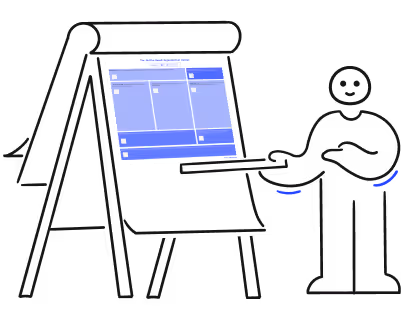Spend less to train more: why any company should automate training management

Empower your organization with the skills-based canvas.

Working in the human resources department in Quebec in 2020 is a real challenge. With an unemployment rate at its lowest since 1976, the workload can only increase. One of the direct consequences of this situation is the difficulty in recruiting and retaining employees.
Circumstances generate higher and higher turnover rates, and therefore a greater workload. Without a good strategy to deal with it, it is a context that can become very costly for an organization.
How does continuous training prevent the disadvantages linked to the shortage of manpower?
Having an HR strategy that includes optimized management of training has several advantages for each company. In circumstances of high turnover, here are the main reasons to invest in the development of your staff:
- Facilitate internal recruitment with learning paths.
- Increase employee productivity and skills.
- Better standardize processes and protocols.
- Attract new talent and propel its employer brand.
However, training management requires time, a good work structure and a lot of follow-ups. It can be complex if you have access to few resources, hence the importance of automating it.
Why automate training management?
In the era of digital transformation, better use of available resources is essential. Several solutions are available so companies can achieve that, and human resources are no exception.
In training management, we consider tools that allow the creation, dissemination, and measurement of courses. Thanks to this kind of service, both Workleap LMS and Folks offer very interesting benefits for organizations.
Let's take a look at some of these benefits.
Budget savings
Creating online training modules is an investment that quickly pays off for the company. Indeed, automating the distribution of content to the employee allows major savings on certain sources of expense, such as:
- The salary of experienced employees required for training.
- The fees of an external trainer.
- The costs that are related to room rental.
Time optimization
Automation encourages less manual management and therefore an increase in productivity. The tools for monitoring registrations and calculating training budgets are good examples. In just a few clicks, you can easily find out who completed which training and how much it cost!
Centralization of data
Training management involves the manipulation of several pieces of information for each employee, such as:
- The certifications required for their position.
- The courses to follow.
- The courses completed.
- The time allocated to each training.
- The cost of completed training.
If you still use several files to monitor and manage those, you will understand that this is a real headache! This is why you need a solution that allows the consultation and organization of this information effectively.
Management of Bill 90
In the province of Quebec, investment in continuous training is controlled under Bill 90, or the famous 1% Law. To comply, companies must submit supporting documents for all eligible expenses.
Once information is centralized, it is much easier to manage costs and the necessary vouchers. The reporting and data entry tools of Workleap LMS and Folks precisely allow this automation. Monitoring for declarations is therefore done in one place and very easily.
How to automate training management?
You probably already offer internal training and want to automate its management. To facilitate this process, we suggest a few key steps that will help you understand how to get there.
Here are the 5 main steps in the management of automated training.
1. Analysis of internal training needs
The training needs of your staff can vary greatly from one employee to another. These needs arise at the time of onboarding, when upgrading knowledge or for continuous improvement. Keeping track of which training should be followed per each employee requires diligent management to make sure nothing goes by.
In your HRMS, you can note and find all this information quickly. In addition to knowing what training should be taken, the required deadlines and certifications are also added. This makes it faster to know who to register for which course.
2. Creation of training content
Hiring external trainers is very costly and requires organization since several employees have to be brought together at the same time. On the other hand, peer training can cause productivity losses. When your best talents are busy training new staff, they don't make money for the company.
With Workleap LMS, your company can set up its online training platform. You can create content using internal documentation and support from external trainers and employees. The advantage is that everything is in the same place and that each employee can progress at their own pace!
3. Management of training registrations
Once you know the training needs and your modules are created, all you have to do is register your staff. Directly on your Workleap LMS platform, you can manage these registrations in several ways.
If you want to add many people to a course, you can do so quickly by creating a group. For example, you could make a group for a department, a management level, a branch, etc. However, if you want to register each employee manually, it is also possible.
If you want to offer additional training, you can display it and allow employees to participate voluntarily. Thus, they become responsible for their professional development under your encouragement.
4. Follow-up of completed training courses
Of course, it is useless to train your staff without doing a follow-up afterward. Although you can directly consult the progress of the students in Workleap LMS, you can also download a completion report.
With this report, you can import the information directly into your HRMS. In just a few clicks, your employee profiles will be up to date with the training completed! If necessary, you can even attach the completion certificate that is generated in Workleap LMS.
5. Budget management
With all the information gathered in one place, it becomes very easy to assess the costs. Directly in your HRMS, you can calculate the employee's salary and other costs related to his training. You can even attach supporting documents to centralize information in the event of an inspection.
Managing Bill 90 (or the 1% Law) has never been easier!
Which of these tools interests you most? Do not hesitate to contact us if you would like more information about our LMS solution! If you have any questions for Folks, it will be our pleasure to put you in touch.
Source: Institut de la statistique du Québec : État du marché du travail au Québec – Bilan de l’année 2019
%20(1).png)

%20(1).avif)


.avif)
.avif)








